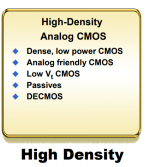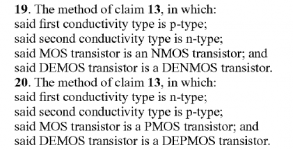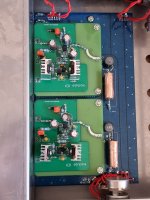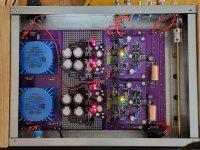Usually large feature size processes also have thick gate oxides. Using more than minimum length in a given process doesn't increase gate oxide thickness, of course.
Check out this link: https://www.ti.com/lit/SLYP795 for info on some of TI's analog IC technology, found via google search. It would indicate that the various IC fabrication processes are designed for analog (and mixed-signal) work, and not tweaks of digital IC processes.
Good sharing, thanks a lot!Check out this link: https://www.ti.com/lit/SLYP795 for info on some of TI's analog IC technology, found via google search. It would indicate that the various IC fabrication processes are designed for analog (and mixed-signal) work, and not tweaks of digital IC processes.
Just to be clear, since the OPA1655/6 are not specifically mentioned in this presentation, we can't conclude that one of the processes listed is the one used for OPA1656. My point is that you can see that TI's analog and mixed signal processes are designed for the intended products, not attempts to tweak low-voltage digital processes to do analog.
The description of HPA9 makes me think of a 180 nm process with high-voltage LDMOS added to it, and with bipolars and JFETs as parasitic devices. No idea what DECMOS is. It's probably what they use for class-D amplifiers with some digital content.
It's all online, just google for TI DECMOS. You'll find US Patent Application number US20150187938A1 which spells out the whole recipe.
Unsurprisingly, DECMOS is a fabrication process which includes both DENMOS and DEPMOS, see claim 19 of the patent application. Prefix DE means Drain Extended.
_
Unsurprisingly, DECMOS is a fabrication process which includes both DENMOS and DEPMOS, see claim 19 of the patent application. Prefix DE means Drain Extended.
_
Attachments
Hi. 1655 in a composite arrangement- diamond buffer global feedback. Sounds sublime. Thank you John and the team. Ive been waiting for these and its been worth it.
One thing tho the datasheet says 165x is a fet opamp tho and not cmos? Im confused
One thing tho the datasheet says 165x is a fet opamp tho and not cmos? Im confused
Attachments
One thing tho the datasheet says 165x is a fet opamp tho and not cmos? Im confused
The marketing people at TI got scared that audio folks wouldn't give a CMOS op amp a chance, and so they just called it a "FET-input". From @johnc124 here : https://www.diyaudio.com/community/...ts-and-advice-appreciated.280243/post-4472958
Thanks.The marketing people at TI got scared that audio folks wouldn't give a CMOS op amp a chance, and so they just called it a "FET-input". From @johnc124 here : https://www.diyaudio.com/community/...ts-and-advice-appreciated.280243/post-4472958
This is same as me telling people that this opamp is the 'best'. People dont wanna accept that everythings a compromise.
not a 1656 but mono channel ? Same behavior and results then ?Hi. 1655 in a composite arrangement- diamond buffer global feedback. Sounds sublime. Thank you John and the team. Ive been waiting for these and its been worth it.
One thing tho the datasheet says 165x is a fet opamp tho and not cmos? Im confused
Yup the preamp its situated in is a dual mono design. It probably performs better than if a single 1656 was used since layouts are easier to optimize in a dual mono.not a 1656 but mono channel ? Same behavior and results then ?
Heres the same preamp with 'wayne's linestage' for modules.
Attachments
Wonder how'the Douglass Self pre from Linear Audio/Carl Huff member's pcb will perform withthe 1656...
John, whats the absolute max supply voltage for the 16xx family?
Ive up the psu to plus minus 19.5v for the opa1641 and its taking it like a champ. Tempted to do the same with 1655 now..
Ive up the psu to plus minus 19.5v for the opa1641 and its taking it like a champ. Tempted to do the same with 1655 now..
When certifying your opa1641 for +/- 19.5V operation, be sure to hit it with freeze spray for 30 sec, and also be sure to hit it with butane BBQ lighter for 30 sec, to ensure plenty of safety margin against delta-temperature variations. Ideally on several different samples.
The datasheet says 40 V between the positive and the negative supply, so that's +/- 20 V with a symmetrical supply. It is not guaranteed to work above +/- 18 V, though, only to survive for a while.
- Home
- Vendor's Bazaar
- OPA1656: High-Performance CMOS Audio Op Amp




